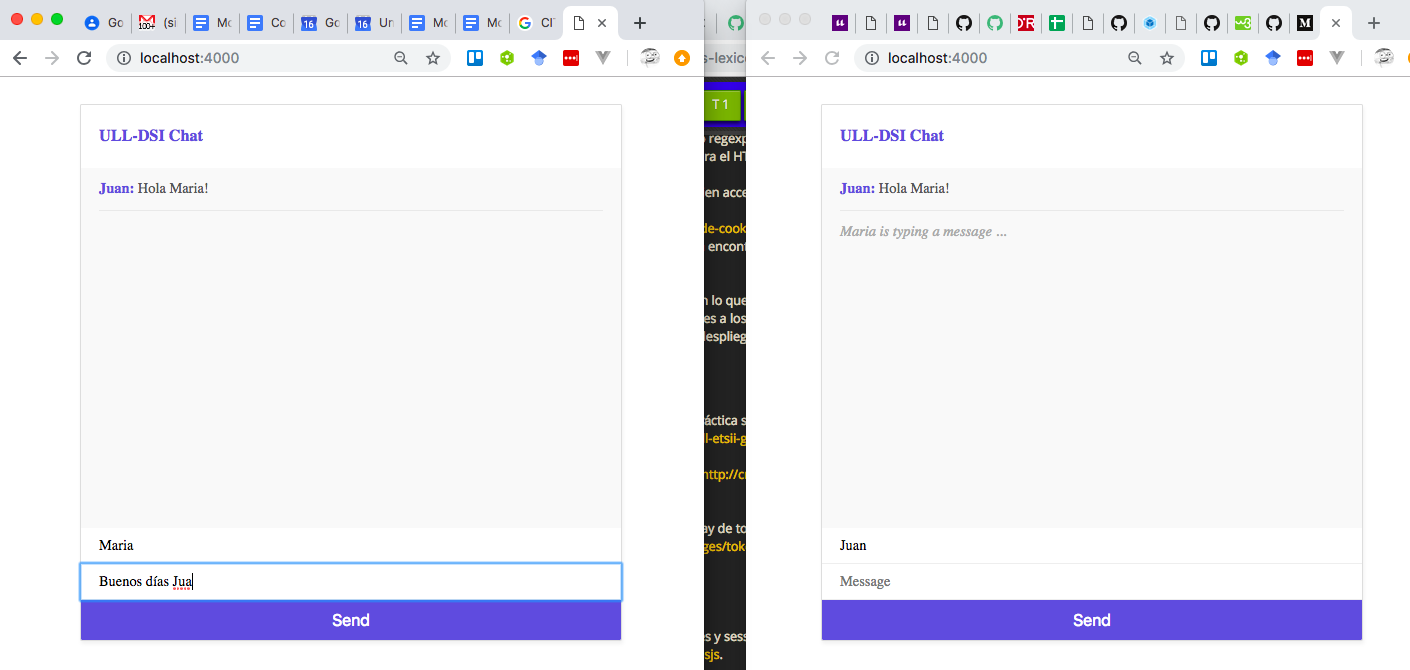Sistemas y Tecnologías Web: Servidor
Master de II. ULL. 1er cuatrimestre. 2020/2021
Organization ULL-MII-SYTWS-2021 Classroom ULL-MII-SYTWS-2021 Campus Virtual SYTWS Chat Chat Profesor Casiano
Table of Contents
Práctica p5-t3-websockets
Lea el capítulo WebSocket del libro The Modern JavaScript Tutorial y haga un resumen de lo aprendido.
Estudie también y desarrolle el ejemplo explicado en:
- Build a simple chat app with node.js and socket.io By Noufel Gouirhate Dec 24, 2017 Medium.com
- Puede encontrar el código en este Repo ULL-ESIT-DSI-1819/simpleChatApp
- Despliegue la aplicación en Heroku y en iaas.ull.es
- Para el despliegue en Heroku deberá leer el artículo: Using WebSockets on Heroku with Node.js
- Repo ULL-ESIT-DSI-1819/websocket-socket-io-heroku
-
Aquí es esencial habilitar session affinity:
1 2
[~/local/src/javascript/learning/websockets/websockets-heroku-socket-io(master)]$ heroku features:enable http-session-affinity Enabling http-session-affinity for ⬢ dsi-socket-io-example... done
Session affinity, sometimes referred to as sticky sessions, is a platform feature that associates all HTTP requests coming from an end-user with a single application instance (web dyno).
- Repo ULL-ESIT-DSI-1819/websocket-ws-heroku
Reto 1 para la práctica p5-t3-websockets
- Add {user} is typing … functionality.

Tip: Decida en que lugar del documento saldrá el mensaje ... is typing
En el HTML, deberá decidir donde va a aparecer el mensaje de feedback indicando que un usuario
esta tecleando y añadirle un id. Por ejemplo:
1
<div id="feedback"></div>
Tip: Como escuchar por las pulsaciones de teclas
Le puede ayudar añadir en el código del cliente una llamada a el método addEventListener:
1
target.addEventListener(tipo, listener);
tipo: Una cadena representando el tipo de evento a escuchar.listener: normalmente la function que será llamada cuando ocurre el eventotiposobre el elemento del DOM representado portarget. En este caso el código delistenerdeberá emitir un mensaje indicando que el usuario esta tecleando.- El server debería recoger el mensaje y hacer un broadcast del mismo al resto de clientes conectados
Reto 2 para la práctica p5-t3-websockets
- Añáda rooms a su chat. Establezca dos rooms llamadas
practicasyocio
Vea los ejemplos en ULL-ESIT-DSI-1819/socket-io-namespaces y lea la sección Namespaces de la documentación de Socket.io
Puede hacer este ejercicio usando namespaces o rooms.
Usando namespaces
En el directorio ns tiene un ejemplo de como usar namespaces:
Fichero ns/index.js
1
2
3
4
5
6
7
8
9
10
11
12
13
14
15
16
17
18
19
20
21
22
23
24
25
26
27
28
29
30
31
32
33
34
35
const path = require('path');
const express = require('express');
const app = express();
const http = require('http').Server(app);
const io = require('socket.io')(http);
// view engine setup
app.set('views', path.join(__dirname, 'views'));
app.set('view engine', 'ejs');
app.use(express.static('public'));
app.get('/:namespace', function(req, res) {
res.render('space', { space: req.params.namespace});
});
function welcome(nsp, socket, spaceName) {
console.log('someone connected to '+spaceName);
socket.emit('hi', `Welcome client '${socket.id}' to ${spaceName}!`);
nsp.emit('hi', `Client '${socket.id}' joined ${spaceName}!`);
}
const nsp = io.of('/my-namespace');
nsp.on('connection', function(socket) {
welcome(nsp, socket, '/my-namespace');
});
const nsp2 = io.of('/your-namespace');
nsp2.on('connection', function(socket) {
welcome(nsp2, socket, '/your-namespace');
});
http.listen(3000, function() {
console.log('listening on localhost:3000');
});
Fichero ns/public/index.html
1
2
3
4
5
6
7
8
9
10
11
12
13
<!DOCTYPE HTML>
<html lang="en">
<head>
<meta charset="UTF-8">
<title></title>
</head>
<body>
<ul>
<li><a href="/my-namespace">my-namespace</a></li>
<li><a href="/your-namespace">your-namespace</a></li>
</ul>
</body>
</html>
Fichero ns/views/space.ejs:
1
2
3
4
5
6
7
8
9
10
11
12
13
14
15
16
17
18
<!DOCTYPE html>
<html>
<head>
<title>Hello world</title>
</head>
<script src="/socket.io/socket.io.js"></script>
<script>
const socket = io('/<%- space %>');
let chat = document.getElementById("chat");
socket.on('hi',function(data) {
chat.innerHTML += `<p>${data}</p>`;
});
</script>
<body>
<div id="chat"></div>
</body>
</html>
Usando rooms
Fichero rooms/index.js:
1
2
3
4
5
6
7
8
9
10
11
12
13
14
15
16
17
18
19
20
21
22
23
24
25
26
27
28
29
30
var path = require('path');
var express = require('express');
var app = express();
var http = require('http').Server(app);
var io = require('socket.io')(http);
// view engine setup
app.set('views', path.join(__dirname, 'views'));
app.set('view engine', 'ejs');
app.use(express.static('public'));
app.get('/:room', function(req, res) {
res.render('room', { room: req.params.room});
});
var nsp = io.of('/my-namespace');
nsp.on('connection', function(socket) {
socket.emit('hi', `Welcome client '${socket.id}' to my-namespace!`);
socket.on('join', function(room) {
console.log("room = "+room);
socket.join(room);
nsp.to(room).emit('hi', socket.id+' joined room "'+room+'"');
});
console.log('someone connected: '+socket.id);
});
http.listen(3000, function() {
console.log('listening on localhost:3000');
});
Fichero rooms/public/index.html:
1
2
3
4
5
6
7
8
9
10
11
12
13
<!DOCTYPE HTML>
<html lang="en">
<head>
<meta charset="UTF-8">
<title></title>
</head>
<body>
<ul>
<li><a href="/room-1">room-1</a></li>
<li><a href="/room-2">room-2</a></li>
</ul>
</body>
</html>
Fichero rooms/views/room.ejs:
1
2
3
4
5
6
7
8
9
10
11
12
13
14
15
16
17
18
19
20
21
<!DOCTYPE html>
<html>
<head>
<title>Hello world</title>
</head>
<script src = "/socket.io/socket.io.js"></script>
<script>
const socket = io('/my-namespace');
socket.emit('join', '<%- room %>');
let chat = document.getElementById("chat");
socket.on('hi',function(data) {
chat.innerHTML += `<p>${data}</p>`;
});
</script>
<body>
<div id="chat"></div>
</body>
</html>
Recursos
- Capítulo WebSocket del libro The Modern JavaScript Tutorial
- WebSockets
- Socket.io
- Chats
- Build a simple chat app with node.js and socket.io - By Noufel Gouirhate Dec 24, 2017 Medium.com
- Web Sockets (Node.js and Socket.io Chat App) in the Net Ninja Youtube Channel
- Introduction to Socket.io by Udara Bibile at Medium.com
- Socket.io & Express NodeJS Tutorial to build a Realtime Chat App
- Real Time Slide Presentation
- Libros
- Programación Web
- Express
- ejs
- Despliegues
- Como Desplegar una Aplicación Web en iaas.ull.es
- Apuntes de Heroku
- Para el despliegue en Heroku deberá leer el artículo: Using WebSockets on Heroku with Node.js
- Repo ULL-ESIT-DSI-1819/websocket-socket-io-heroku
-
Aquí es esencial habilitar session affinity:
1 2
[~/local/src/javascript/learning/websockets/websockets-heroku-socket-io(master)]$ heroku features:enable http-session-affinity Enabling http-session-affinity for ⬢ dsi-socket-io-example... done
Session affinity, sometimes referred to as sticky sessions, is a platform feature that associates all HTTP requests coming from an end-user with a single application instance (web dyno).
- Webpack